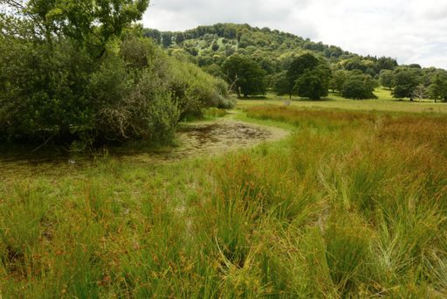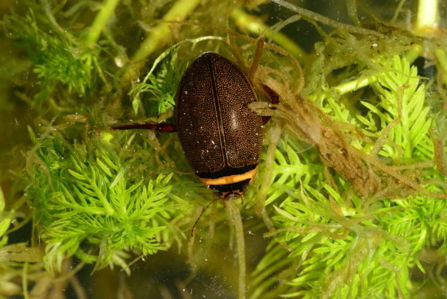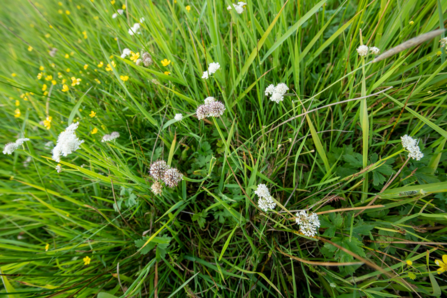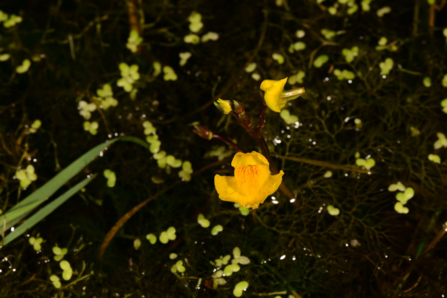Ice Age Ponds are not only geologically interesting, but they represent an incredible ecosystem which has survived since they were formed in the last glacial retreat, 20,000 years ago! These ponds have a restricted distribution in the UK, partially due to their formation being dependent on a hummocky moraine, and that many ponds were lost at the end of the 20th century due to development and farming. Here in Herefordshire, approximately 25% of our ponds are still of their natural origin, compared to 2% nationally, highlighting how it is imperative that we work to preserve this stronghold of Ice Age Ponds.
Ice Age Pond’s Spotlight Species

Moccas Park Ice Age Pond
These ponds have rich species assemblages which include a range of rare, protected species. One of their most important characteristics is that many of our Ice Age Ponds are not wet all year round, instead, they are ephemeral. This means that for as much as nine months a year, the ponds dry up completely! This provides unique conditions for wildlife, allowing certain species to thrive.
Great Crested Newt
Let's start exploring the importance of Ice Age Ponds with their show stopper species - the Great Crested Newt (Triturus cristatus). These amphibians are the largest and rarest of the UK’s newts. Thanks to their complex life cycles, these newts perform important ecological functions and contribute to ecosystem services, such as nutrient cycling, which inadvertently benefits us. Great Crested Newts have been calling the UK their home for approximately 40 million years, but their population is now threatened by habitat loss and farming intensification. The UKs population is internationally important, warranting their protection by law, underneath the Wildlife and Countryside Act (1981) and being listed as a European Protected Species.
Great Crested Newts have relatively large ranges (of a couple 100m) and ideally need a few different ponds within this range. Luckily, the hummocky moraine of Herefordshire meets this criteria, with Ice Age Ponds often developing in clusters. The ponds’ ephemeral nature meet the newts second need. For its young to survive to adulthood, they must avoid predation by fish. With the majority of Ice Age Ponds drying out in later summer, this provides the perfect, predator free environment for newt tadpoles and efts to grow and develop, where they can reach the final terrestrial stage of their life cycle and move out of the pond as it recedes in the summer.

Great Crested Newt Female © Will Watson
Another property that makes our Ice Age Ponds so perfect for the rare newts is their typically high diversity. Newts have a very varied diet, from blood worms and shrimp when young, to slugs and worms in adulthood. This means that ponds need to have a healthy, diverse ecosystem to support the newts prey species. This includes a high quality surrounding habitat to ensure there is plenty of prey for when the newts emerge and turn to hunting on the land. Unfortunately, not all our ponds in Herefordshire tick this final box, but the Wildlife Trust and our partners are working really hard to improve the species diversity and surrounding habitat to ensure they meet the needs of these special animals, allowing them to thrive across the county.
Ice age ponds are also very important for other more common amphibians, such the Common Toad (Bufo bufo) and Smooth Newt (Lissotriton vulgaris) for many of the same reasons.
Medicinal Leech
Maybe one of our less appealing Ice Age Pond super stars, but if you find a Medicinal Leech (Hirudo medicinalis) it is something to be excited about - honest! Being the largest leech in the UK, the medicinal leech population here has dramatically declined over the past century and they are now protected by law under the Wildlife and Countryside Act (1981). Medicinal Leeches were originally exploited for their medical uses, with trade peaking in the nineteenth century, leading to population declines. However in more recent years, it is thought that changes in land use, wetland drainage and the introduction of worming treatments such as Ivermectin have been responsible for their demise.

Medicinal Leeches © Simon Williams
Although little is known about their exact habitat requirements, they appear to prefer shallow ponds and ditches that have fluctuating water levels and dry up in the summer months. They are also found in sites that are regularly grazed, as this provides both a food source for the leech and maintains vegetation at the edge of the ponds. It just so happens that Ice Age Ponds, with their ephemeral nature and frequently being found on grazed pasture (in Herefordshire at least) meet the leeches' needs!
In Herefordshire, there is only one pond that is known to contain these fascinating creatures, which is found in Moccas Park. Wouldn’t it be great if we saw the establishment populations of this important species in our other Ice Age Ponds too?
Aquatic Beetles
Beetles are another invertebrate that calls Ice Age Ponds their home. Although they may all look the same at a glance, once you get up close and personal, you discover the fascinating world of beetles, and the huge variety it holds. There are more than 100 species of aquatic beetles in the UK alone! At Mocca’s Park, one of our ponds contains a number of nationally rare species which can only be found at the one pond within the whole of Herefordshire (that’s how important our Ice Age Ponds really are!). Graphoderus cinereus, which is listed Vulnerable on the IUCN Species list; Dytiscus circumflexus (another nationally rare species) and Agabus uliginosus can all only be found at Mocca’s Park across the whole of Herefordshire!

Graphoderus cinereus at Moccas Park © Will Watson
Aquatic Plants
Don’t let the fauna steel all the thunder, there are some pretty exciting plants that can only be found in Ice Age Ponds too!
The Tubular water dropwort (Oenanthe fistulosa), thread-leaved water crowfoot (Ranunculus trichophyllus) and water violets (Hottonia palustris) are all restricted to Ice Age Ponds.

Tubular Water Droplet © Will Watson
But the pond at Mocca’s Park is home to a more sinister plant species. Bladderwort (Utricularia vulgaris) has turned to a meaty preference to meet its appetite. Being one of the UKs few native carnivorous plants, it supplements its diet with small aquatic insects. The name refers to the bladder-like traps which are used to vacuum small invertebrates through a trapped door and into the sack. Here, digestive enzymes are secreted to break down its prey, providing the bladderwort with lots of nutrients. Once the meal is finished, the bladder opens again and expels the remains and is ready for its next victim. After overwintering at the bottom of the pond, small yellow flowers are produced at the surface in the spring and summer which resemble small snapdragons.

Bladderwort in flower
Indicator species
As well as being a refuge for rare and specialised species, Ice Age Ponds, if in good enough condition, can be home to indicator species. These are species that can only survive where there is a fully functioning, biodiverse ecosystem. Therefore, their presence at a pond indicates a healthy ecosystem and a high quality habitat.
Water Stick Insects (Ranatra linearis) are underwater predators and use their front legs to catch prey, just like a praying mantis. Its tail acts like a snorkel, allowing it to breath underwater. These are good indicators for a high quality pond.
Another species that depends on a high diversity of pond species is the Small Red-Eyed Damselfly (Erythromma najas), which, despite their name, are mainly black!
In case you weren’t already excited by Ice Age Ponds, hopefully after reading this you will have learnt about how important they are for some special species! And this is the shortened list - there are many more species that depend on these ponds for survival!
Next time you visit one of our reserves, keep an eye out for some of these pond specialists. If you are lucky, you may spot a newt crawling along the pond edge, a diving beetle drifting through the water or a damselfly dashing across the pond surface.

